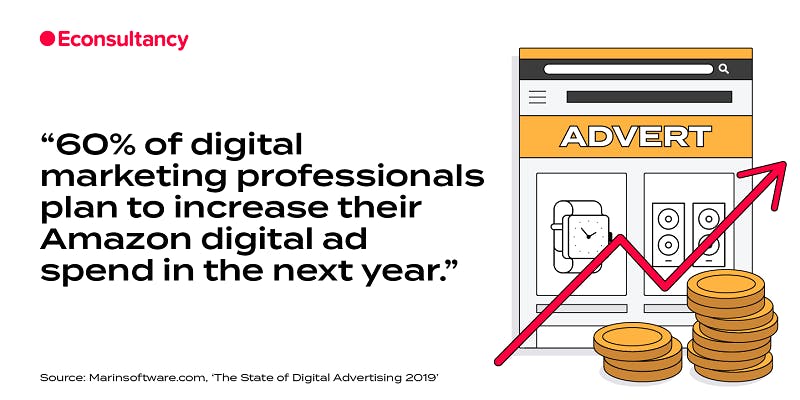It’s ‘stat’ time of the week again…
This week’s round up includes news about Amazon, live video, programmatic audio, and lots more.
Check out the Internet Statistics Database while you’re here too; it’s jam-packed with further stats and insight.
60% of digital marketing professionals plan to increase their Amazon digital ad spend in the next year
Marin’s latest ‘State of Digital Advertising’ report has delved into how advertisers are spending their budgets in 2019.
The study – based on a survey of 460 digital marketers – found that paid search remains the dominant digital ad channel, commanding 39% of total budget. This was followed by paid social, which claimed 18% of budget, and display which claimed 16%.
Marin also found that brands are now spending almost as much of their paid social budget on Instagram (21%) as they are on Facebook (27). However, 67% of respondents said that Instagram spend tends to come from incremental budget rather than transferring from Facebook.
Finally, the report suggests that advertisers are seeing increased potential in Amazon from an advertising perspective, with 60% of respondents planning to increase their Amazon spend over the next year. 55% of respondents said they started using Amazon because they see it as a significant growth opportunity, while one in four are looking to increase purchases at the lower end of the funnel.

Amazon: Lessons and Success Stories
Amazon sells over 175 million items on Prime Day
New data from Amazon has revealed that Amazon Prime Day 2019 was bigger than both Black Friday and Cyber Monday combined, as consumers bought over 175 million items online during the 48-hour event.
In 2018, Amazon sold around 100 million items, with the event only lasting 36 hours. During Prime Day 2019, members bought 100,000 lunchboxes, 100,000 laptops, 200,000 TVs, 300,000 headphones, 350,000 luxury beauty products, 400,000 pet products, 650,000 household cleaning supplies, and more than one million toys.
There were also more new members to Amazon Prime on July 15th than any previous day, and almost as many on July 16, making these the two biggest days ever for member signups.
Thank you, Prime members, for making this #PrimeDay the largest shopping event in our history! You purchased more than 175 million items, from devices to groceries! pic.twitter.com/Tvb9oCO3os
— Amazon.com (@amazon) July 17, 2019
Twitch accounts for 72.2% of all live-streamed video hours during Q2 2019
Twitch is the number one platform for live video, according to new figures from StreamElements. The platform, which is owned by Amazon, accounted for 72.2% of all live-streamed video hours in Q2 2019.
Prior to this, Twitch experienced a 2% decline in viewing time to 2.72 billion hours in Q2 from Q1. However, the platform still outperformed YouTube Live, which saw more than 735 million hours of viewership in Q2, as well as Facebook Gaming and Mixer, which saw nearly 200 million and 112 million hours of viewership respectively.
The majority of Twitch’s viewing time stems from the popularity of individual streamers (rather than esports events). The platform’s top 5,000 streamers collectively generated two billion hours of viewing time in Q2.
Pro skills take many forms. pic.twitter.com/CjkZpxqwvb
— Twitch (@Twitch) July 18, 2019
60% of marketers want to increase programmatic audio spend over the next 18 months
A new study by Xaxis has found that EMEA marketers are seeing greater opportunity in programmatic audio, as 60% of its survey respondents want to increase spend in this area over the next 18 months.
Currently, 59% of marketers say they are already utilising the capabilities of programmatic audio to some extent, however, spend is low. 79% invest less than 10% of total ad spend on audio, and 41% allocate no budget to programmatic audio at all.
The top three drivers for investing in audio advertising are recognised as complementing the media mix, reaching specific audiences, and raising brand awareness. Meanwhile, 63% of marketers cited achieving targeting efficiencies as a key driver for investing in programmatic audio, while 44% cited taking advantage of data insights.
Xaxis goes on to highlight challenges for marketers, with the two biggest barriers to exploring audio investment being a clear understanding of the impact of programmatic audio trading on total revenue, and the availability of technology.
Optimising Programmatic Campaigns – Best Practice Guide
Almost half of US consumers shop from DTC brands
IAB’s Disrupting Brand Preference report suggests that nearly half of US consumers now purchase from direct-to-consumer brands, with these shoppers typically being younger than consumers who shop from traditional brands.
In a survey of 3,000 US consumers, IAB found that 48% of respondents shop from DTC brands, and that 84% of these shoppers are under the age of 54.
The study also found that direct brand consumers are 83% more likely to go to a pop-up or physical store location pre-purchase, and are nearly 2.5x more likely to consult celebrities or influencers online pre-purchase. 71% of these consumers also say they usually share online about the brands they buy from, with 31% sharing brand-created content online.
 Ads are perceived 74% more favourably in high quality environments
Ads are perceived 74% more favourably in high quality environments
Finally, new research from Integral Ad Science (IAS) has found evidence to suggest that an ad’s environment has a dramatic impact on how people react to the ad. The study monitored 50 people during a 30-minute mobile experience, tracking and recording brain activity in real-time.
Overall, IAS found that ads viewed in high-quality mobile web environments were perceived 74% more favourably than the same advertisements seen in low-quality environments. In other words, consumers liked ad creative more when seen next to high-quality content, and actively disliked ads when they appeared next to lower quality content.
In addition to ads being perceived more favourably, the study also found that high quality content can generate up to a 20% higher engagement rate and up to a 30% greater memorability among consumers than in low-quality environments.

A Guide to Digital Advertising








